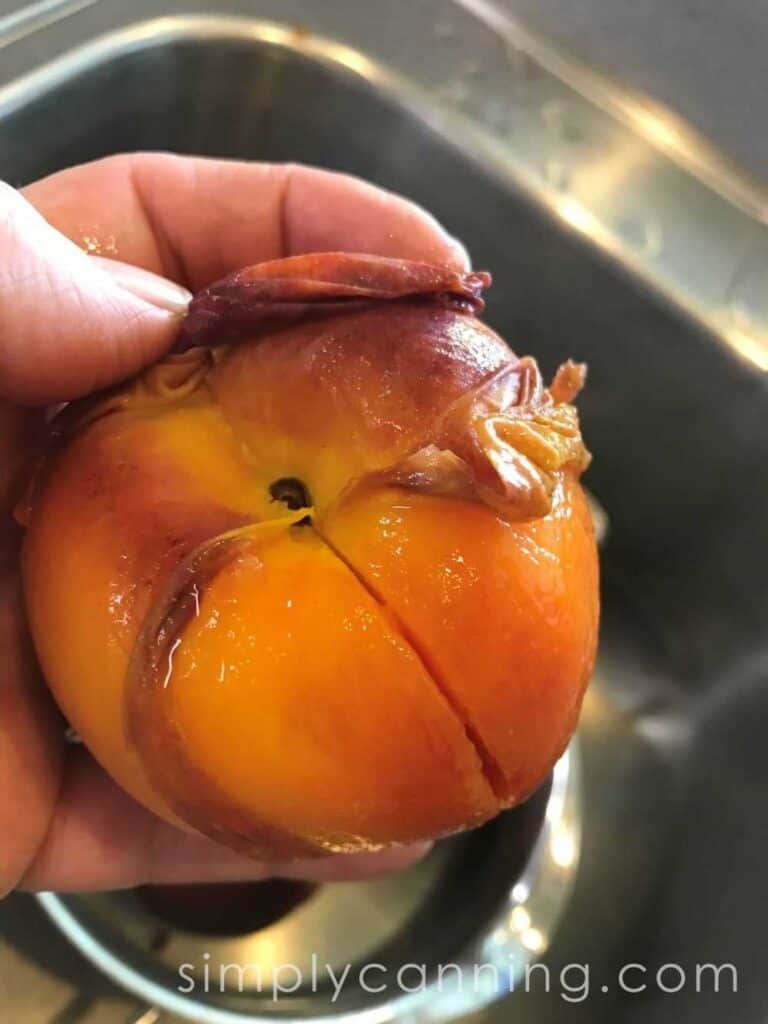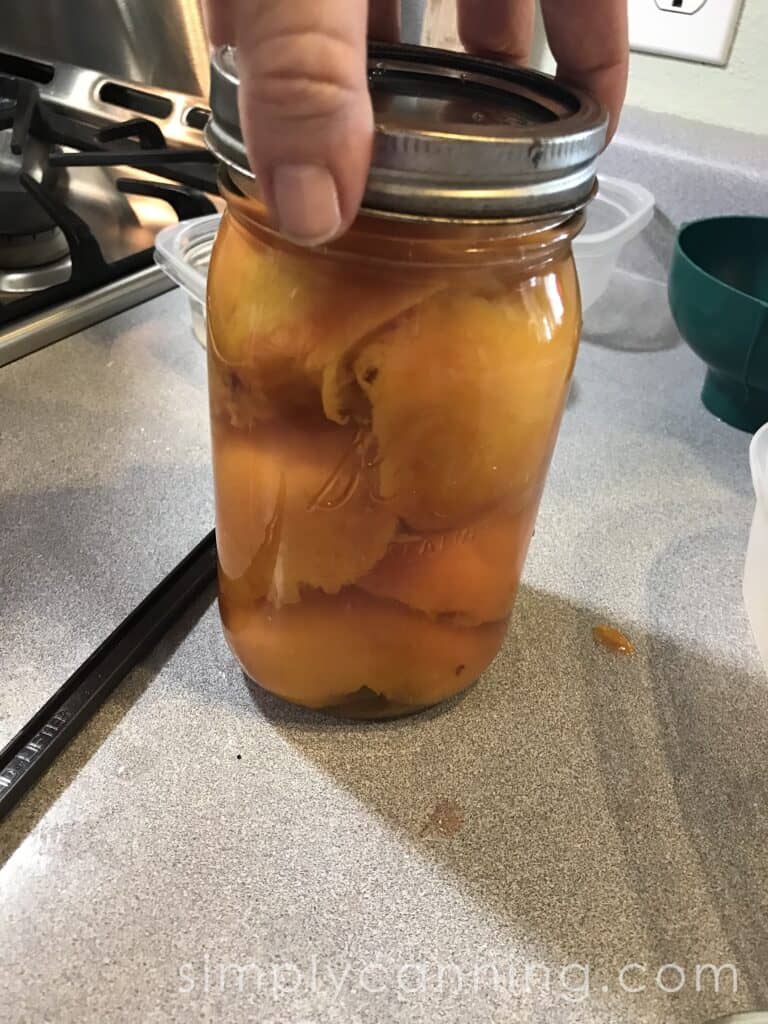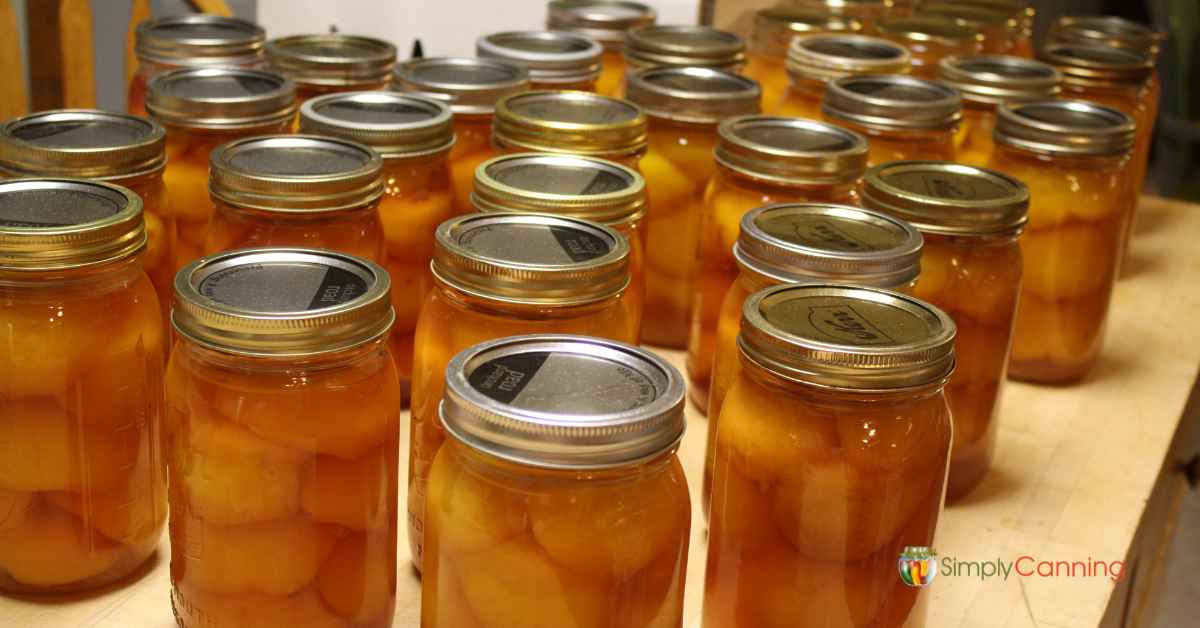Canning Peaches
This page may contain affiliate links. More Information.
Canning Peaches – Does anything beat picking a peach fresh off the tree and eating it right there? Canning peaches is a delightful way to save the taste of fresh peaches throughout the year. If you’re a beginner eager to try this project you’re in the right place. In this guide, I’ll take you through the step-by-step process of how to can peaches.
Canning Peaches:
- Gather supplies and prepare jars and canner.
- Prepare syrup (optional) or use water for canning.
- Choose between raw pack and hot pack methods.
- Peel, slice, and pit peaches.
- Pack peaches into jars and cover with syrup.
- Seal jars and place them in the canner.
- Process jars in water bath or steam canner for specified times.
Canning Peaches; extended directions for beginners.
Know Your Canner
Before you begin, it’s essential to familiarize yourself with either the water bath canner or the steam canner. I’ve got a couple of resources to get you up to speed if you are not familiar with them: “How to Use a Water Bath Canner” and “How to Use a Steam Canner.”
Quantity:
These quantities are an estimate. About 17.5 pounds would make 7 quarts of home canned peaches. That is about 2.5 pounds per quart. About 11 pounds for 9 pints.
Start by gathering your supplies and ingredients. Prepare your jars and get the water in your canner heating. The goal is that your canner and jars will be hot when the peaches are ready to go in the jars.
Supplies for Canning Peaches:
- Canner – water bath or steam
- canning jars
- canning seals and rings
- jar lifter and canning funnel
- large pot or blancher
- large bowls
- large spoons
- sharp knife
- towels and dishcloths
- ladle
Ingredients:
- peaches
- sugar – for the syrup (optional)
Syrup for Canning Peaches
Prepare light or medium syrup if desired. (I prefer a light syrup for canning peaches – see ratio below.) Simply heat water and syrup in a pot until sugar dissolves. I like to do this right in a tea pot. The pour spout makes it easy to pour the syrup over the peaches in the jars.
Canning Peaches with Sugar Syrup
- Light – 2 cups sugar to 1 quart water
- Medium – 3 cups sugar to 1 quart water
Canning Peaches with Honey Syrup
You can also make syrup with honey if you don’t want to use processed sugar.
- Light – 1 1/2 cups honey to 4 cups water
- Medium – 2 cups honey to 4 cups water
Canning Peaches with No Sugar
Did you know…? You don’t have to add any sugar if you don’t want to. You can simply use plain water. Sugar is not a preservative in this case.
Warning though…. Sugar does help the fruit to maintain flavor, color, and texture. Some sugar, even just a light syrup, is highly recommended for quality. I’ve read that canning fruit in water can wash out the flavor of your fruit.
Another maybe better alternative is to use a fruit juice. This will help maintain color and texture without adding processed white sugar. Apple Juice and white grape juice are great light tasting sweet alternatives.
How to Peel Peaches for Canning




Peel peaches by blanching for 30 seconds to 1 minute and then slipping off the skins. Cut in halves or slices and add to your jar.
- Blanch peaches in boiling water for 30 seconds to 1 minute.
- Immediately remove the peaches to a sink or bowl with cold water to stop the cooking.
- Cut along the ‘seam’ in your peach.
- Slice the peaches in half and remove the pits. The skins should slip right off.
You’ll notice a “seam” down one side of your peach. If you slice around the diameter of the peach following this line, you will be able to pluck the pit right out.
Skins should slip right off in your hands. If your peach is a little green, it will be harder to skin, and you can just use a paring knife for the stubborn spots.
Pack Peaches into Jars and Cover with Syrup
You can either hot or raw pack peaches. It is up to you. NCHFP mentions that raw pack is a
lower quality product, but raw pack is still my preference.




Raw pack vs Hot pack method.
Canning Peaches – Raw Pack: I prefer to raw pack and fill one jar at a time as I peel, pit, and slice. I then immediately cover the peaches with hot syrup and place in hot water in canner to keep warm while I prepare the next jar. This prevents peaches from browning. Leave 1/2-inch headspace.
Canning Peaches – Hot Pack: Slice peaches into a pot of syrup. When you have enough fruit prepared for your jars, bring to boil and turn off heat. Fill jars with hot fruit and cooking liquid, leaving 1/2-inch headspace.
A few things to help you decide.
- If you hot pack (i.e. heat the peaches before packing your jars), you will be able to fit more into the jar.
- If you raw pack, it is a quicker way to get the food packed and preserved but you may have more fruit floating in the jar. This is not a safety issue just a cosmetic flaw.
- There is a small difference in processing time for raw vs hot pack so pay attention to that when it comes to processing your jars.
Choosing halves or sliced peaches.
I usually just peel and slice the peaches and place them right into a jar. I like to can peaches in halves, but you may also cut them smaller if you wish. Halves, Quarters or slices are fine.
Pack peach halves cavity side down. They pack better, so you will fit more in a jar. If you have wide mouth jars, it makes it easier to place the peaches in the bottom of the jar cavity side down.
After jars are packed with peaches.
- Add your choice of hot syrup. Cover peaches and leave a 1/2 inch headspace.
- Release any air bubbles that may be trapped in the jar. Bubbles are common with peaches. Run a bubble tool down each side of the jar and move things around. This will release any air that is trapped between peaches. There is a bubble tool that comes in handy, or you can simply use any thin plastic utensil.
- Recheck headspace and adjust if needed. De-bubbling will sometimes affect the headspace. Add a bit of syrup if needed to get the 1/2 inch headspace.
- Wipe the rims of your jars off so you will not leave any sugary residue or bits of peaches to interfere with the sealing of the lid. Use a damp paper towel or a lint free cloth to clean things up.
- Place your canning lids and rings on. This simply means add the flat lid (it will fit with the rubber sealing compound over the rim of the jar) then add a screw band to hold the lid down during processing. The screw band does not need to be super tight. Finger tight is what is recommended. Tight enough to hold the lid on comfortably. Don’t crank down hard. It is not needed.
- Then place the jar in your canner.
Process in a Water Bath or Steam Canner
Now that your jars are filled you’ll start the canning process.
Choose: Steam canning or water bath canning?
I’ve included instructions for water bath canning but this is a great project for a steam canner too. Steam canning is now my go to whenever it is possible. If you want to process with a steam canner you’ll use the same processing time but follow the instructions on how to use a steam canner.
How long to water bath peaches.
- Raw Pack: Process pints for 25 minutes, quarts for 30 minutes.
- Hot Pack: Process pints for 20 minutes, quarts for 25 minutes.
Some Common Questions and Canning Tips
Freestone vs Clingstone Peaches
- Freestone peaches are those where the pit or “stone” comes out easily when cut open.
- Clingstone peaches have flesh that ‘clings’ to the pit and it is difficult to remove.
Either will work but I will always opt for freestone peaches when canning they are much easier to prepare. With clingstone peaches, the flesh gets mushed up… it’s almost impossible to avoid it.
I will say that some people insist that clingstone is better as the texture of the peach is nicer after canning.
Expert tip… save the clingstone peaches for jam!
Sharon
White Peaches vs Yellow Peaches
Choose yellow peaches for canning. White peaches have lower acidity levels, which can pose safety concerns. There are no tested directions for either pressure canning or water bath canning white peaches.
Pressure Canning Peaches
I have been asked on several occasions about pressure canning peaches. So I’ll give some instructions here. It IS possible but honestly I don’t recommend it. I think the water bath or steam canning is sufficient.
For pressure canning peaches you will follow the same procedures as above for filling your jars and then process in a pressure canner for 10 minutes either pints or quarts; hot or raw pack. The pressure you’d use will depend on your altitude and is is as follows.
Pay attention to the proper time for the proper equipment.
- use the chart for the style of pressure canner you are using.
- check the altitude adjustments for your altitude.
- Dial Gauge – Watch the dial on your canner to determine pressure.
- Altitude – Weight (pounds pressure)
- 0-2000 – 6 lbs
- 2001-4,000 – 7 lbs
- 4,001-6,000 – 8 lbs
- 6,001-8,000 – 9 lbs
- Weighted Gauge – Watch for the weight to ‘jiggle’ to determine pressure.
- Altitude – Weight (pounds pressure)
- 0-1000 ft – 5 lbs
- Above 1000 – 10 pounds
Source – National Center for Home Food Preservation accessed August 29, 2023
Why Are My Peaches Floating?
Floating peaches is something that happens usually in raw pack style peaches. It is due to trapped air within the fruit or the jar. It is simply cosmetic. There is nothing wrong with your peaches. Here are some tips to try to avoid this.
- Pack the peaches snugly in the jar without crushing them.
- Remember to release air bubbles.
- Use the appropriate headspace as indicated in the recipe.
I Lost Liquid in My Home Canned Peaches
Losing liquid in canned peaches can happen for various reasons, including inadequate headspace, a poor seal, or temperature fluctuations during processing. Here are some tips to try and avoid this.
- Ensure the recommended headspace is maintained when filling the jars.
- Properly process the jars, but don’t over process. In a water bath the water should be a rolling boil, but that does not have to mean boiling so hard it is splashing out of the pot. The water should be rolling and bubbles active.
I’ve got more on liquid loss (sometimes called siphoning) and potential reasons for it.
Adding Spices to Home Canned Peaches
Do you like a little cinnamon with your peaches? You can safely add a little bit of spice to your syrup. Be sure you are using dried spices not fresh. A little goes a long way! Test it with small amounts first.
If you have any spices with substance take them out before you fill your jars. For instance if you like cloves you can simmer whole cloves in your syrup, but remove them before filling jars. Don’t put them in a jar… that jar will be much too strong!
More Frequently Asked Questions
What Do I Do If My Jar Doesn’t Seal?
If your jar doesn’t seal after processing, don’t fret. You have a few options:
Allow the jar to cool completely and then reprocess it using a new lid and following proper guidelines. (Your peaches may be over cooked.)
Refrigerate the contents and consume within a few days.
Alternatively, you can opt for freezing. This would avoid the mush peach issue of reprocessing.
How Long Do Home Canned Peaches Last?
Home canned peaches have a shelf life of around 1 to 1.5 years when stored in a cool, dark place. This is a quality issue more than a safety issue. Peaches will start getting soft after this length of time.
Lemon juice is not required in canning peaches. It will not hurt anything. In fact it might just a a bit of tartness to the flavor if you like that. But it is not needed for safety reasons.
Water bath or steam canning is the preferred method for canning peaches due to their high acidity. Pressure canning is not necessary and can result in texture issues. If you still choose pressure canning, be cautious of mushy peaches due to higher temperatures
Both freezing and canning are viable methods, each with its own advantages. Freezing preserves texture but requires freezer space. Canning provides shelf-stable preservation, but peaches might soften over time. The choice depends on your preference and available resources. I almost never freeze peaches. Canning is my go to. (dehydrating is a close second!)
Treat them just as you would a can of peaches from the store, which usually keeps a few days to a week or so. Peaches with sugar will last longer than if you canned them with no sugar, as the sugar does help preservation. Watch for any mold or spoilage.
According to the National Center for Home Food Preservation, do not can white-flesh peaches, because of their low acidity. Instead, can yellow-flesh peaches

Sources
- https://fyi.extension.wisc.edu/safefood/files/2019/08/SafeSubstitutions.pdf
- Ball Blue Book
- National Center for Home Food Preservation










I found using new, clean needle nose pliers will easily pull out pits with little fruit lose and clean removal.
Thank you, I used your guide to can my peaches for the first time.
Thank you for making this simple and to the point! I hate having to go through someones life story to get my answers. 🙂
Aw thanks Wendy. But do have a little sympathy for content creators. In order to get high search results on google you need to have more content on a page. Back when blogging was a new thing it was mostly personal stories. Most of us now know better and include more educational material. I appreciate your support and letting me know. It is always a boost to hear when someone is getting help with our content. :).
Thank you for the reply. 4mo later I wouldn’t mind the life story if say it pertained to the recipe at hand. Like the day spent with grandparents from sun up to sun down as a child learning the craft. The “work/life balance” in most things I think maybe works best. I still love your content and enjoy learning new things to add to my tool box or recipe box. 😋🥰
I have canned some fresh peaches using the water bath. My jars have cooled and sealed but I have bubbles in my jars. What did I do wrong?
Nothing at all, Jo! 🙂 Sometimes the boiling leads to bubbles inside the jars. As long as they’re sealed completely, it’s fine!
-Rachel (Sharon’s assistant)
love reading on your site. how do you can figs ?
Great question! Here’s a source from Oregon State University on preserving figs: https://extension.oregonstate.edu/sites/default/files/documents/8836/sp50648preservingfigs.pdf
The NCHFP has recipes for fig preserves and fig jam as well. 🙂
-Rachel (Sharon’s assistant)
I want to find a decent recipe for spiced peaches.
I don’t do it myself so I don’t have quantity recommendations but you can add some cinnamon to the jars if you like with no safety concerns.
I love your site and I’m a member of the canning classes
Thanks so much, Karen! So happy to have you here. 🙂
-Rachel (Sharon’s assistant)